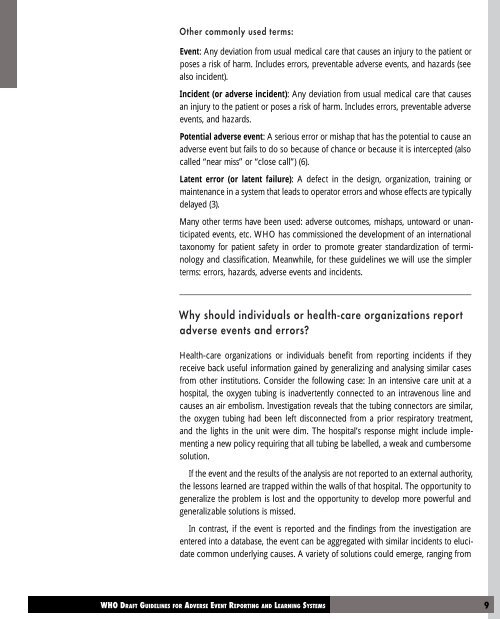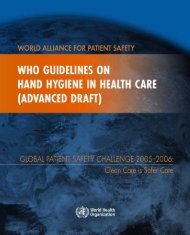Adverse event reporting.pdf
Adverse event reporting.pdf
Adverse event reporting.pdf
You also want an ePaper? Increase the reach of your titles
YUMPU automatically turns print PDFs into web optimized ePapers that Google loves.
Other commonly used terms:<br />
Event: Any deviation from usual medical care that causes an injury to the patient or<br />
poses a risk of harm. Includes errors, pr<strong>event</strong>able adverse <strong>event</strong>s, and hazards (see<br />
also incident).<br />
Incident (or adverse incident): Any deviation from usual medical care that causes<br />
an injury to the patient or poses a risk of harm. Includes errors, pr<strong>event</strong>able adverse<br />
<strong>event</strong>s, and hazards.<br />
Potential adverse <strong>event</strong>: A serious error or mishap that has the potential to cause an<br />
adverse <strong>event</strong> but fails to do so because of chance or because it is intercepted (also<br />
called “near miss” or “close call”) (6).<br />
Latent error (or latent failure): A defect in the design, organization, training or<br />
maintenance in a system that leads to operator errors and whose effects are typically<br />
delayed (3).<br />
Many other terms have been used: adverse outcomes, mishaps, untoward or unanticipated<br />
<strong>event</strong>s, etc. WHO has commissioned the development of an international<br />
taxonomy for patient safety in order to promote greater standardization of terminology<br />
and classification. Meanwhile, for these guidelines we will use the simpler<br />
terms: errors, hazards, adverse <strong>event</strong>s and incidents.<br />
Why should individuals or health-care organizations report<br />
adverse <strong>event</strong>s and errors?<br />
Health-care organizations or individuals benefit from <strong>reporting</strong> incidents if they<br />
receive back useful information gained by generalizing and analysing similar cases<br />
from other institutions. Consider the following case: In an intensive care unit at a<br />
hospital, the oxygen tubing is inadvertently connected to an intravenous line and<br />
causes an air embolism. Investigation reveals that the tubing connectors are similar,<br />
the oxygen tubing had been left disconnected from a prior respiratory treatment,<br />
and the lights in the unit were dim. The hospital’s response might include implementing<br />
a new policy requiring that all tubing be labelled, a weak and cumbersome<br />
solution.<br />
If the <strong>event</strong> and the results of the analysis are not reported to an external authority,<br />
the lessons learned are trapped within the walls of that hospital. The opportunity to<br />
generalize the problem is lost and the opportunity to develop more powerful and<br />
generalizable solutions is missed.<br />
In contrast, if the <strong>event</strong> is reported and the findings from the investigation are<br />
entered into a database, the <strong>event</strong> can be aggregated with similar incidents to elucidate<br />
common underlying causes. A variety of solutions could emerge, ranging from
















